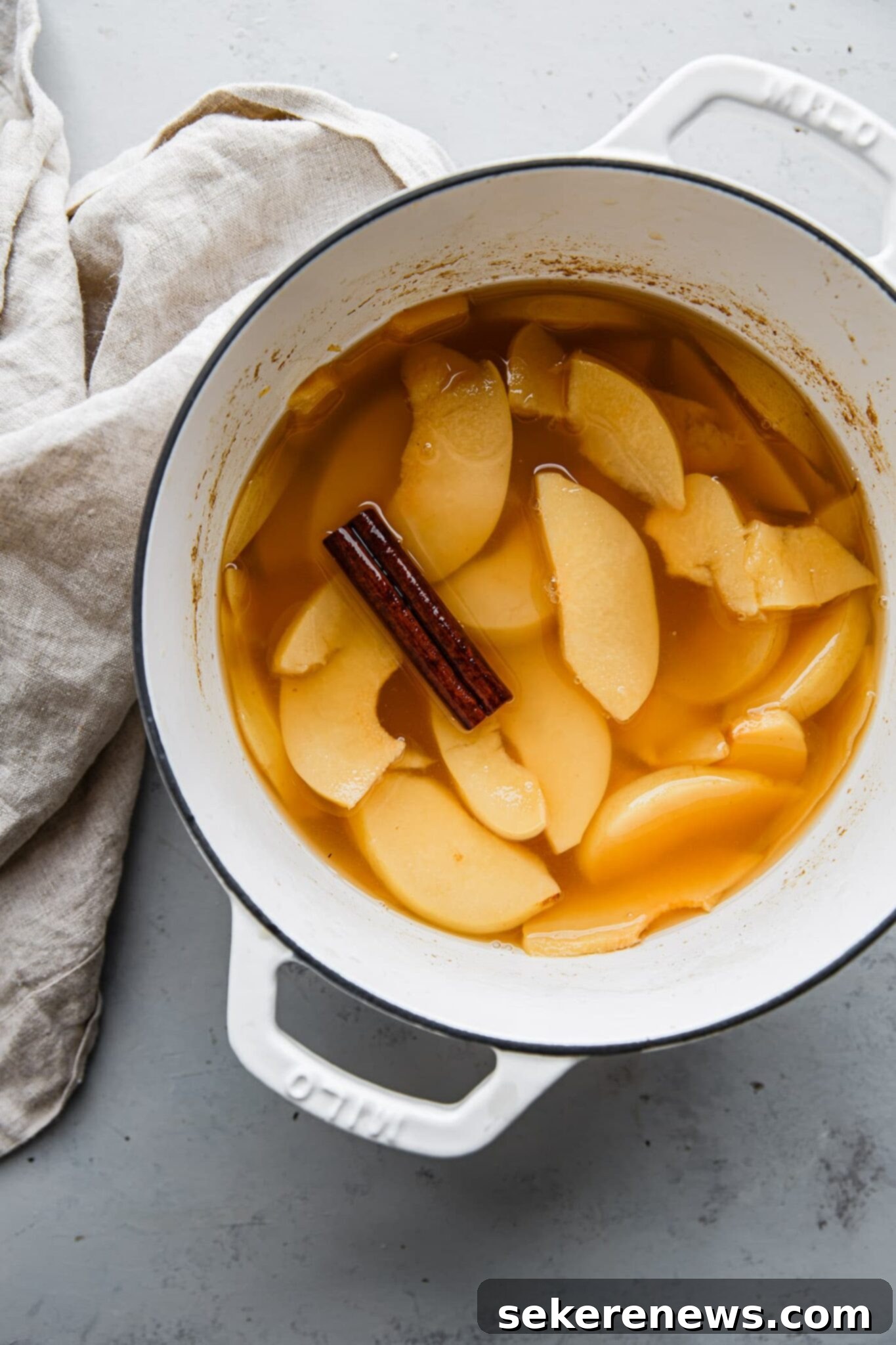Perfectly Poached Quince: Your Guide to a Fragrant & Simple Fall Dessert
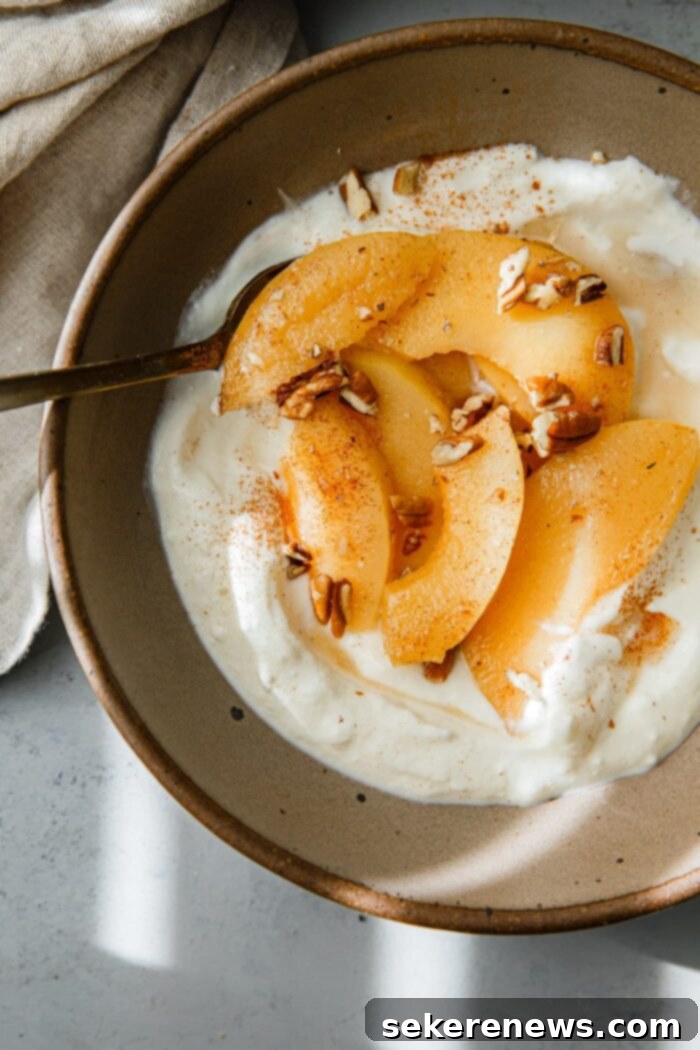
As the crisp air of autumn descends, our cravings often turn to warm, comforting, and naturally sweet treats. While apples and pumpkins tend to dominate the fall culinary scene, there’s an often-overlooked gem that truly shines with a little care: the quince. Poached fruit, in general, is one of the best and most underutilized seasonal desserts or accompaniments, and quince stands out as a particularly enchanting candidate for this gentle cooking method.
Today, we’re taking a delightful detour from the usual fall staples to embrace the unique charm of this fragrant fruit. This simple Poached Quince recipe transforms the humble quince into a tender, spice-infused delicacy that’s as beautiful to behold as it is delicious to eat. Imagine the sweet, floral aroma filling your kitchen as these golden fruits slowly simmer, absorbing the rich flavors of honey and warm spices.
Once cooked to perfection, poached quince becomes a versatile and delicious treat. Enjoy it on its own for a light yet satisfying dessert, spoon it over creamy yogurt or a scoop of vanilla ice cream for an elevated indulgence, or add it as a luxurious topping for fluffy pancakes or crispy waffles. Its subtle sweetness and tender texture make it a perfect complement to both breakfast and dessert dishes, promising a taste of sophisticated autumn comfort in every bite.
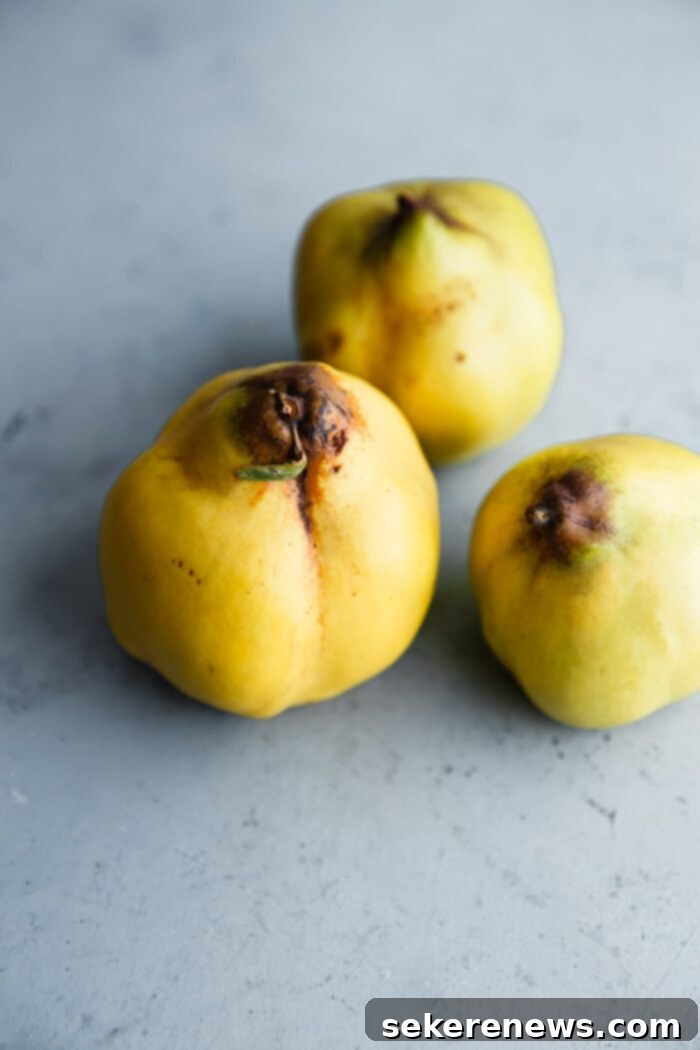
What Are Quince and Why Poach Them?
Quince are the fruit of the Cydonia oblonga tree, native to the Middle East and Caucasus region. Often described as a cross between an apple and a pear, their flavor profile is far more nuanced and distinct. When raw, quince are typically irregular in shape, firm, and have a fuzzy, yellowish-green skin that often turns bright yellow when fully ripe. Most strikingly, they possess a very distinctive, intensely flowery aroma, with notes of citrus, vanilla, and sometimes even tropical fruits, unlike either an apple or a pear.
The fruit itself is *very* tough, astringent, and gritty when raw, making it unsuitable for eating fresh. This is precisely why poaching is the ideal cooking method. Once cooked, quince undergoes a magical transformation: its flesh softens considerably, becoming beautifully tender and luscious. The astringency disappears, replaced by a delicate sweetness, and its pale yellow interior often deepens into a lovely rose-pink hue, absorbing the flavors of the poaching liquid beautifully. This transformation makes poaching not just a cooking method, but a necessity to unlock the quince’s true culinary potential.
When prepping quince, you’ll notice it oxidizes quickly once sliced, much like apples. To minimize browning, it’s best to prepare your quince slices just before adding them to the poaching liquid. While many traditional recipes call for meticulously removing the peel, the tough skin actually softens considerably once cooked and becomes a non-issue, especially if the fruit is sliced thinly. Leaving the peel on also adds to the rich, rosy color and provides additional flavor and nutrients. However, if you prefer a perfectly smooth texture or are unsure, you can easily remove the skin with a vegetable peeler prior to slicing.
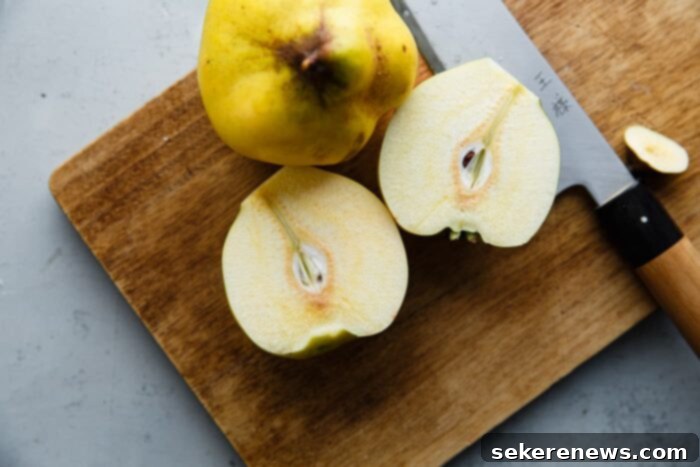
Quince Shopping Tips: Finding the Perfect Fruit
Quince season generally runs from September to December, making it a perfect fall and early winter delight. They can sometimes be a bit hard to find in conventional grocery stores, but they are often available at specialty supermarkets, international markets (especially those with a focus on Mediterranean or Middle Eastern cuisine), or local farmer’s markets during their peak season. Don’t be shy about asking your local grocer if they can source them for you!
When selecting quince, look for large, mostly yellow fruit with minimal green spots, indicating ripeness. The fruit should be very firm and hard to the touch, even when ripe. Avoid any quince with soft spots, bruises, or significant blemishes. A good quince will also have a strong, sweet, and fragrant aroma, even before it’s cooked. Store them at room temperature if you plan to use them within a few days. For longer storage, wrap them loosely in plastic and keep them in the refrigerator, where they can last for up to two months. If you wish to freeze quince, consider poaching and slicing them first, then freezing them in their poaching liquid for best results.
Essential Ingredients for Fragrant Poached Quince
Crafting delicious poached quince requires a careful balance of sweet, spicy, and aromatic elements. Here’s a closer look at the key ingredients you’ll need and why they’re so important:
- Quince: Naturally, this is the star of our dish! As discussed, prioritize ripe, firm, and fragrant quince for the best results. If quince is truly unavailable, you can adapt this poaching method and liquid for other firm fruits like Bosc pears or Granny Smith apples, though the cooking time and resulting flavor will differ.
- Honey and Granulated Sugar: To create a rich, perfectly balanced poaching liquid, we use a combination of honey and granulated sugar. Similar to our Pear Frangipane Tart, we’ll aim for a roughly 4:1 liquid to sugar ratio, ensuring the liquid is sweet enough to infuse the fruit without being syrupy. Honey adds a beautiful floral depth and complexity that sugar alone cannot provide, while granulated sugar contributes straightforward sweetness and helps achieve the desired liquid consistency. You could substitute maple syrup for the honey for a different autumnal flavor profile, or use all sugar if preferred, adjusting to taste.
- Aromatics and Spices: These are crucial for infusing the quince with layers of warm, inviting flavor:
- Cinnamon Stick: A quintessential fall spice, providing warmth and sweetness that beautifully complements the quince’s natural notes.
- Whole Cloves: These pungent, aromatic buds offer a deep, spicy undertone that pairs exceptionally well with quince. Just a few whole cloves impart significant flavor without overwhelming the fruit.
- Fresh Lemon Peel: Not just for garnish, two-inch strips of lemon peel (avoiding the bitter white pith) contribute essential citrus brightness, cutting through the sweetness and adding a vibrant, fresh aroma to the poaching liquid. The citrus oils in the peel are key for this.
- Fresh Ginger: A thin, unpeeled round slice of fresh ginger root introduces a subtle, zesty warmth and a delicate peppery note that enhances the overall spice profile.
- Pure Vanilla Extract or Vanilla Bean Paste: Vanilla is a powerful flavor enhancer, adding a rich, creamy sweetness and rounding out the spicy aromatics. For an even more intense vanilla flavor, consider splitting a vanilla bean and adding it to the poaching liquid.
- Pinch of Kosher Salt: A tiny bit of salt might seem counterintuitive in a sweet dish, but it’s essential for balancing and enhancing all the other flavors, preventing the final product from tasting flat.
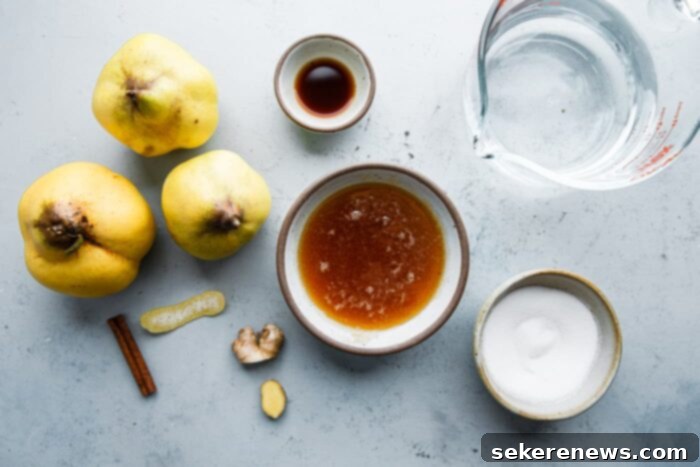
How to Poach Quince: Step-by-Step Perfection
Poaching quince is a straightforward process that yields incredibly rewarding results. Follow these steps for perfectly tender and flavorful fruit:
- Prepare the Fragrant Poaching Liquid: In a large, heavy-bottomed saucepan (ideally 4-5 quarts to accommodate the quince and liquid), combine the cold water, liquid honey, granulated sugar, cinnamon stick, whole cloves (if using), fresh lemon peel, ginger root slice, and a pinch of kosher salt. Place the saucepan over medium heat and stir occasionally to help dissolve the sugar. Bring the mixture to a gentle simmer, just until the sugar is completely dissolved and the aromatics begin to release their intoxicating scents. Once simmering, remove it from the heat temporarily while you prepare your parchment lid (cartouche) and slice the quince.
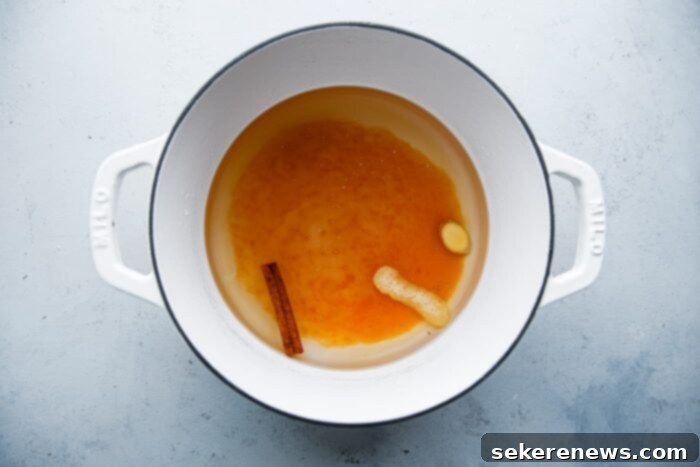
- Carefully Chop and Core the Quince: Quince flesh is remarkably tough when raw, so a steady hand and a large, very sharp chef’s knife are essential for safety. First, carefully slice each quince in half lengthwise. Using a sturdy melon baller, scoop out and discard the fibrous core and any seeds. Alternatively, if you don’t have a melon baller, cut the halves into quarters and carefully slice away the core with a small paring knife. Once cored, place the quince pieces cut-side down on your cutting board and slice them into uniform ¼-inch thick pieces. This consistent thickness ensures even cooking. Immediately transfer the quince slices to the prepared hot poaching liquid, ensuring they are mostly submerged. Remember, quince oxidizes quickly, so work efficiently during this step.
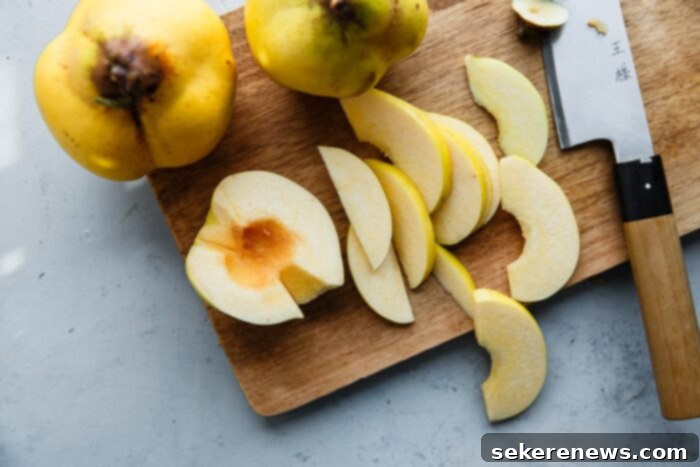
- Gentle Poaching with a Parchment Lid: Return the saucepan with the quince and poaching liquid to a very low simmer. Now, cover the surface of the liquid directly with your pre-cut parchment paper round (a “cartouche”). This is a crucial step as it keeps the fruit submerged in the liquid, ensuring even cooking and preventing the top slices from drying out. Gently simmer the quince, flipping the slices once or twice during cooking, for approximately 20 to 25 minutes, or until they are perfectly tender when pierced with a knife. Cooking times can vary based on the ripeness and thickness of your quince, so I highly recommend checking for tenderness after 10 to 15 minutes and adjusting the time as needed. The quince will also continue to gently cook as they cool in the hot liquid, so don’t overcook them at this stage.
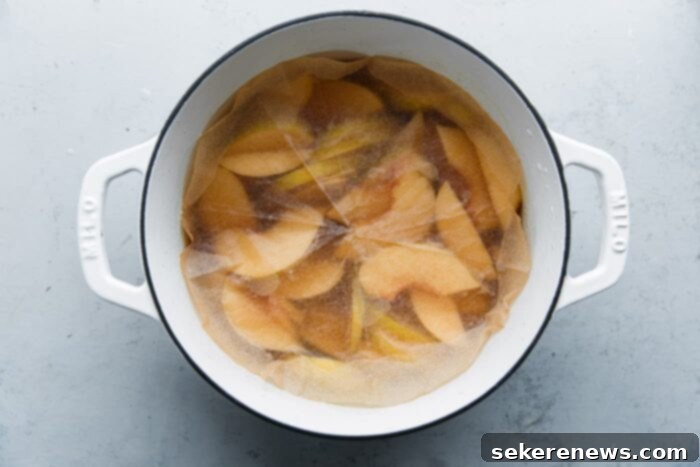
- Cool and Store for Enhanced Flavor: Once tender, remove the saucepan from the heat. Allow the quince to cool completely to room temperature while still submerged in the fragrant poaching liquid. This step is vital, as it allows the fruit to continue absorbing the beautiful flavors of the spices and sweeteners, further enhancing its tenderness and developing its lovely rosy hue. Once cool, you can serve immediately or transfer the quince slices and their liquid to a large airtight container. Store them in the poaching liquid in the refrigerator for up to one week for the best flavor and texture. Before serving or storing long-term, remember to remove the larger spices like the cinnamon stick, lemon peel, and ginger slice, as their flavors can become too intense over time.
Creative Ways to Serve Poached Quince
Like other delicately poached or stewed fruits, poached quince is incredibly versatile and can elevate a variety of dishes. Its tender texture and sweet, fragrant profile make it suitable for both sweet and savory applications:
- Breakfast & Brunch: Spoon poached quince over your morning Greek yogurt, oatmeal, granola, or cottage cheese for a healthy and satisfying start to your day. It’s also a fantastic, elegant topping for pancakes, waffles, or French toast.
- Dessert Delights: Pair it with a scoop of premium vanilla bean ice cream or a dollop of mascarpone, crème fraîche, or whipped cream for a simple yet sophisticated dessert. It can also be incorporated into tarts, crumbles, cheesecakes, or used as a filling for turnovers.
- Savory Pairings: Don’t limit quince to sweet dishes! Its natural sweetness and slight tartness make it an excellent accompaniment to roasted meats like pork, duck, or chicken. It also adds a unique touch to cheese boards, complementing both aged and fresh cheeses beautifully.
- Salads & Spreads: Slice poached quince thinly and add it to autumnal salads with nuts, greens, and goat cheese. You can also mash it lightly to create a quick compote or spread for toast.
Don’t Waste a Drop: Uses for Leftover Poaching Liquid!
The fragrant, spiced liquid left after poaching quince is a treasure trove of flavor – certainly don’t throw it out! This rich syrup is too delicious to discard and has numerous culinary applications:
- Poach More Fruit: Use it as a base to poach additional batches of quince, or try it with other firm fruits like pears or apples. The flavors will only deepen with each use.
- Simple Syrup: This spiced liquid makes an exceptional simple syrup for cocktails and mocktails. Add a splash to sparkling water, iced tea, or lemonade for an aromatic twist. It can also sweeten hot teas or coffees.
- Glaze or Sauce: Reduce the liquid on the stovetop over medium heat until it thickens into a glossy glaze. This reduction is fantastic drizzled over cakes, tarts, roasted meats, or even plain yogurt.
- Jelly or Jam Base: The pectin released from the quince into the liquid, combined with the sugar, makes it an excellent base for a quick jelly or as part of a homemade jam.
- Baking: Use it in place of plain water or milk in recipes like scones, muffins, or even a simple cake batter to infuse them with delicate quince and spice flavors.
To store, simply transfer the leftover poaching liquid to an airtight container and refrigerate for up to 10 days. For longer preservation, it freezes beautifully. Just thaw it overnight in the fridge before using.
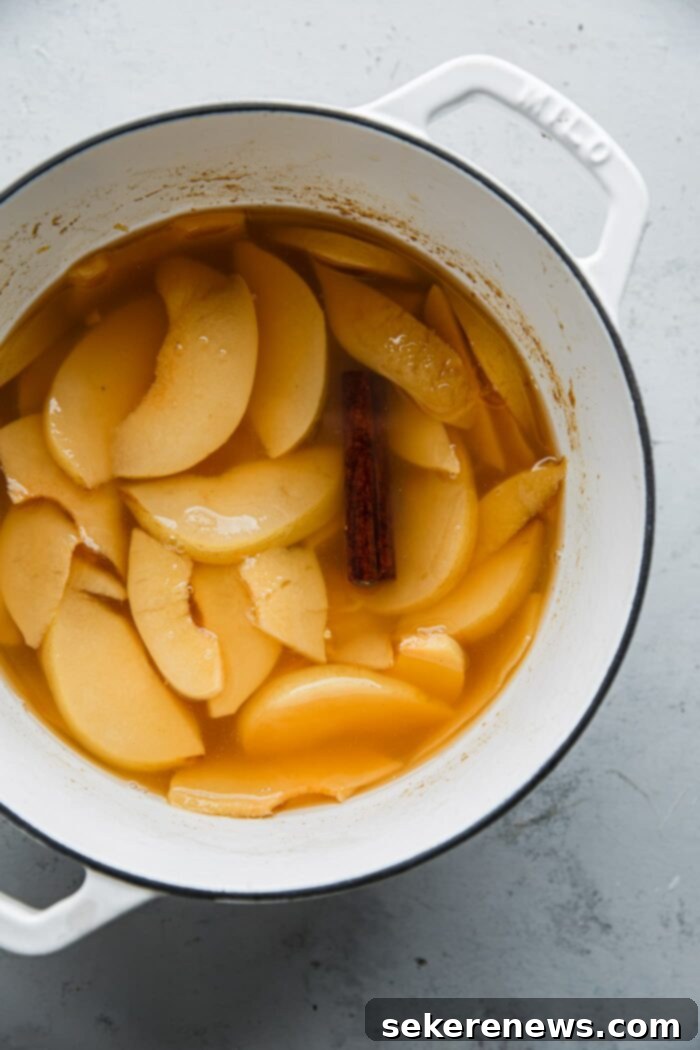
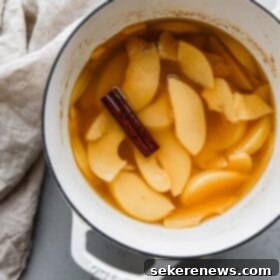
Simple Poached Quince
Pin
Review
SaveSaved!
Quince season generally runs from September to December. They can be hard to find, but can often be available at speciality supermarkets or farmer’s markets during the fall months. Look for large, mostly yellow (with minimal green) quince that are very firm and hard even when ripe. Store at room temperature, if using soon, or wrapped loosely in plastic in the refrigerator for up to two months.
Equipment
-
4-5 Quart Saucepan
-
Natural Parchment Paper
Ingredients
Poaching Liquid:
- 3 cups (720 mL) cold water
- ½ cup (170g) liquid honey
- ¼ cup (50g) granulated sugar
- 4 whole cloves optional, but highly recommended for depth of flavor
- 1 cinnamon stick
- 2 (2-inch long) strips fresh lemon peel use a peeler and minimize any white pith for best flavor
- 1 (¼-inch thick) round slice fresh (unpeeled) ginger root adds a subtle warmth
- 2 teaspoons pure vanilla extract or vanilla bean paste or 1 vanilla bean, split
- pinch kosher salt enhances all flavors
Fruit:
- 2-3 large quince (roughly 1½-1¾ lbs) ensure they are ripe and firm; see prep instructions below
Instructions
-
Make the Parchment Lid (Cartouche): Begin by cutting or tearing a piece of parchment paper that is slightly larger than the diameter of your saucepan (ensure it’s a 4 to 5-quart size). Fold this circular or square piece of parchment in half, then fold it in half once more. You will now have a rough square of folded parchment. Next, fold the square into a triangle by bringing one folded edge to another. Repeat this process twice more, folding it into an even smaller triangle.
Roughly line up the pointed tip of the triangle with the ‘estimated’ center of your saucepan. Using a pair of scissors, carefully cut the parchment along the curve of the saucepan’s edge to create a perfect circle. Unfold the parchment paper. It should now cover the entire surface of your saucepan; being slightly larger is preferable as it helps keep the fruit fully submerged. Set this homemade lid aside for later.

-
Prepare Poaching Liquid: In your chosen saucepan, combine the cold water, liquid honey, granulated sugar, whole cloves (if using), cinnamon stick, lemon peel, ginger, vanilla extract (or paste/bean), and a pinch of salt. Place the saucepan over medium heat and bring the mixture to a gentle simmer, stirring occasionally to ensure the sugar has completely dissolved. The liquid should be fragrant but not yet boiling vigorously. Once simmering and the sugar is dissolved, remove the saucepan from the heat to allow the flavors to steep slightly while you finish prepping the quince and your parchment lid (cartouche).

-
Note: For this recipe, we will not peel the quince. The skin, though tough raw, softens beautifully once cooked and contributes to the fruit’s rich, rosy color. This also removes an extra prepping step, which is helpful as quince flesh oxidizes quickly once exposed to air.
Chop Quince: Carefully slice each quince in half lengthwise, as the flesh is very tough and requires a steady hand and a large, sharp knife. Using a sturdy melon baller, remove and discard the fibrous core and any seeds. Alternatively, you can cut the halves into quarters and then use a small paring knife to carefully slice away the core. Place the cored pieces cut-side down on your cutting board and slice them into uniform ¼-inch thick slices. Immediately transfer these quince slices to the hot poaching liquid in the saucepan. Ensure that the slices are mostly submerged in the liquid.

-
Poach the Quince: Return the saucepan to the stovetop and bring the poaching liquid back to a very low simmer. Place the prepared parchment round (cartouche) directly on the surface of the liquid, covering the quince slices. This helps ensure even cooking and keeps the fruit submerged. Simmer the quince gently, flipping the slices once or twice during the cooking process to ensure even doneness, for approximately 15 to 25 minutes or until they are tender when pierced with a knife. Total cook time will vary depending on the ripeness and thickness of your quince, so it’s crucial to start checking after 10 to 15 minutes and adjust the time as needed. Keep in mind that the quince will continue to cook and soften as they cool in the hot poaching liquid.

-
Cool and Store: Once the quince is tender, remove the saucepan from the heat. Allow the quince to cool completely to room temperature while remaining in the poaching liquid. This crucial step allows the fruit to fully absorb the delightful flavors and further soften, developing its characteristic rosy color. Once cool, you can serve the poached quince immediately. For storage, transfer the quince slices and their poaching liquid to a large, airtight container and refrigerate for up to one week. Before serving or storing for longer periods, remember to remove the larger aromatics such as the cinnamon stick, lemon peel, and ginger slice, as their flavors can become too intense. The leftover poaching liquid can be saved and used for poaching other fruit, as a simple syrup in cocktails, or reduced to a lovely glaze.

Ways to Use Leftover Poaching Liquid:
- Leftover poaching liquid is a concentrated burst of flavor! Use it to poach more batches of quince or other firm fruits like pears or apples. It also makes a fantastic spiced simple syrup for cocktails, mocktails, iced tea, or sparkling water. For a richer texture, it can be reduced and thickened on the stovetop to create a beautiful glaze for desserts or savory dishes.
- Store any leftover poaching liquid in a clean, airtight container in the refrigerator for up to 10 days. For longer storage, freeze it in ice cube trays or freezer-safe containers (and thaw overnight in the fridge before using).
